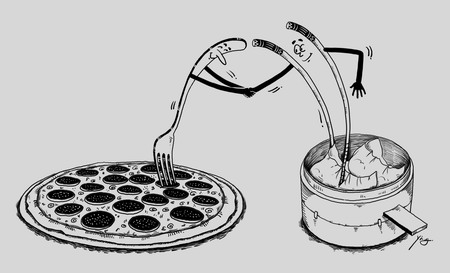View
Cook your way to the Chinese mind
By Berlin Fang (China Daily)
Updated: 2011-01-21 08:10
 |
Large Medium Small |

It may not be a profound truth. But I have just discovered that Chinese food (and cooking) and Chinese thinking have a lot to do with each other.
It all starts with measurement. In cooking, we Chinese don't have "1 cup", "1/4 cup", and "1 teaspoon" kind of measurement. We just say "add a little salt". Perception of "a little" is a matter of exposure (to other cooks), exchange (of experience) and experience (of one's own practice). We don't say "preheat oven to 200 C" either. We say "small fire", "medium fire", and "big fire". The Chinese mind is conditioned to process such chaotic vagueness with ease and patience.
When Americans eat meat, it's usually a huge chunk; for example, steak. Salads, on the other hand, are strictly from the green kingdom. In comparison, we Chinese are omnivores! We mix beef, beans and spring onions (and liberally hot pepper in my case), and stir-fry them.
We are as much stir-fry eaters as we are stir-fry thinkers. On the brighter side, this makes us more holistic thinkers, going fluidly from one thing to another with ease. But there might be risk of sloppy thinking when irrelevant variables are associated with each other, such as the United States' healthcare reform and the currency manipulation debate. For example, some Chinese authors (you are reading one now) add one thing after another into a paper the way we eat from a hot pot.
Similar is the case in medicine. Practitioners of traditional Chinese medicine will frown upon a colleague who treats a headache by examining just the head through something like a magnetic resonance imaging, or MRI. We see the human body as an interconnected whole that is bigger than the sum of all its parts. In the US, some geniuses crafted health insurance in a way that most plans don't pay for dental treatment - as if teeth were not part of the human body!
Let's return to the kitchen. A typical Chinese kitchen has bowls, plates, chopsticks, knives, chopping boards, spoons, and that's about it. We use chopsticks to cook, serve, eat and even have soup.
American kitchens, on the other hand, have a dazzling variety of tools, each for a special purpose. Most of these purposes are mysterious in their use to a poor foreigner. For instance, what do we need a long tube-like sucker in a kitchen for? I learned later that it's a tool to suck extra gravy when roasting turkey.
Once an American friend gave us a box full of kitchen tools while shifting home. I didn't know what most of the tools were for, so I gave some of them to our Chinese friends. They didn't know what they were either, so they passed them on to somebody else. Since the Chinese community in the small town wasn't very large, soon these fancy tools made their way back to me.
We Chinese depend less on specialized tools when we think. We are learning to do that from the US and other countries, though, and hence the training workshops on balanced scorecard, SWOT analysis, fishbone diagrams, Gagne's 9 instructional events and what not.